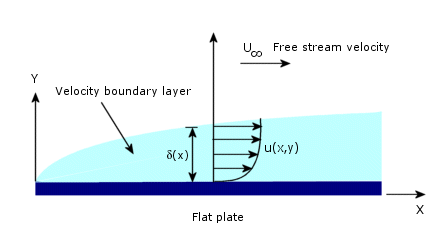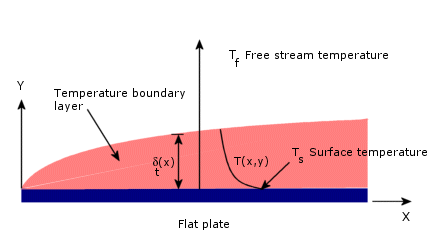Newton's law of cooling states that the heat transfer rate leaving a surface at temperature Ts into a surrounding fluid at temperature Tf is given by the equation:
Qconvection = h A (Ts - Tf)
where the heat transfer coefficient h has the units of W/m2.K or Btu/s.in2.F. The coefficient h is not a thermodynamic property. It is a simplified correlation to the fluid state and the flow conditions and hence it is often called a flow property.
Convection is tied to the concept of a boundary layer which is a thin layer of transition between a surface that is assumed adjacent to stationary molecules and the flow of fluid in the surroundings. This is illustrated in the next figure for a flow over a flat plate.

Where u(x,y) is the x-direction velocity. The region up to the outer edge of the fluid layer, defined as 99% of the free stream velocity, is called the fluid boundary layer thickness δ(x).
A similar sketch could be made of the temperature transition from the temperature of the surface to the temperature of the surroundings. A schematic of the temperature variation is shown in the next figure. Notice that the thermal boundary layer thickness is not necessarily the same as that of the fluid. Fluid properties that make up the Prandtl Number govern the relative magnitude of the two types of boundary layers. A Prandtl Number (Pr) of 1 would imply the same behavior for both boundary layers.

The actual mechanism of heat transfer through the boundary layer is taken to be conduction, in the y-direction, through the stationary fluid next to the wall being equal to the convection rate from the boundary layer to the fluid. This can be written as:
h A (Ts - Tf) = - k A (dT/dy)s
Thus the convection coefficient for a given situation can be evaluated by measuring the heat transfer rate and the temperature difference or by measuring the temperature gradient adjacent to the surface and the temperature difference.
Measuring a temperature gradient across a boundary layer requires high precision and is generally accomplished in a research laboratory. Many handbooks contain tabulated values of the convection heat transfer coefficients for different configurations.
The following table shows some typical values for the convective heat transfer coefficient:
| Medium |
Heat Transfer Coefficient h (W/m2.K)
|
| Air (natural convection)
|
5-25
|
| Air/superheated steam (forced convection)
|
20-300
|
| Oil (forced convection)
|
60-1800
|
| Water (forced convection)
|
300-6000
|
| Water (boiling)
|
3000-60,000
|
| Steam (condensing)
|
6000-120,000
|